A technology road map depicts how a company intends to manage the innovations (such as new sensors or energy storage technologies) needed to launch new products or services that satisfy customers' needs, while also supporting the enterprise's strategy (Exhibit 1). It also shows the connection between bottom-up project realities and the organization's top-down vision and strategy, and it lays out a sequence of projects that enables innovation in the next two to three product life cycles. Additionally, a road map can shine a light on "white spots" and illuminate fields worth investigating for innovation opportunities that may materialize as the marketplace changes.
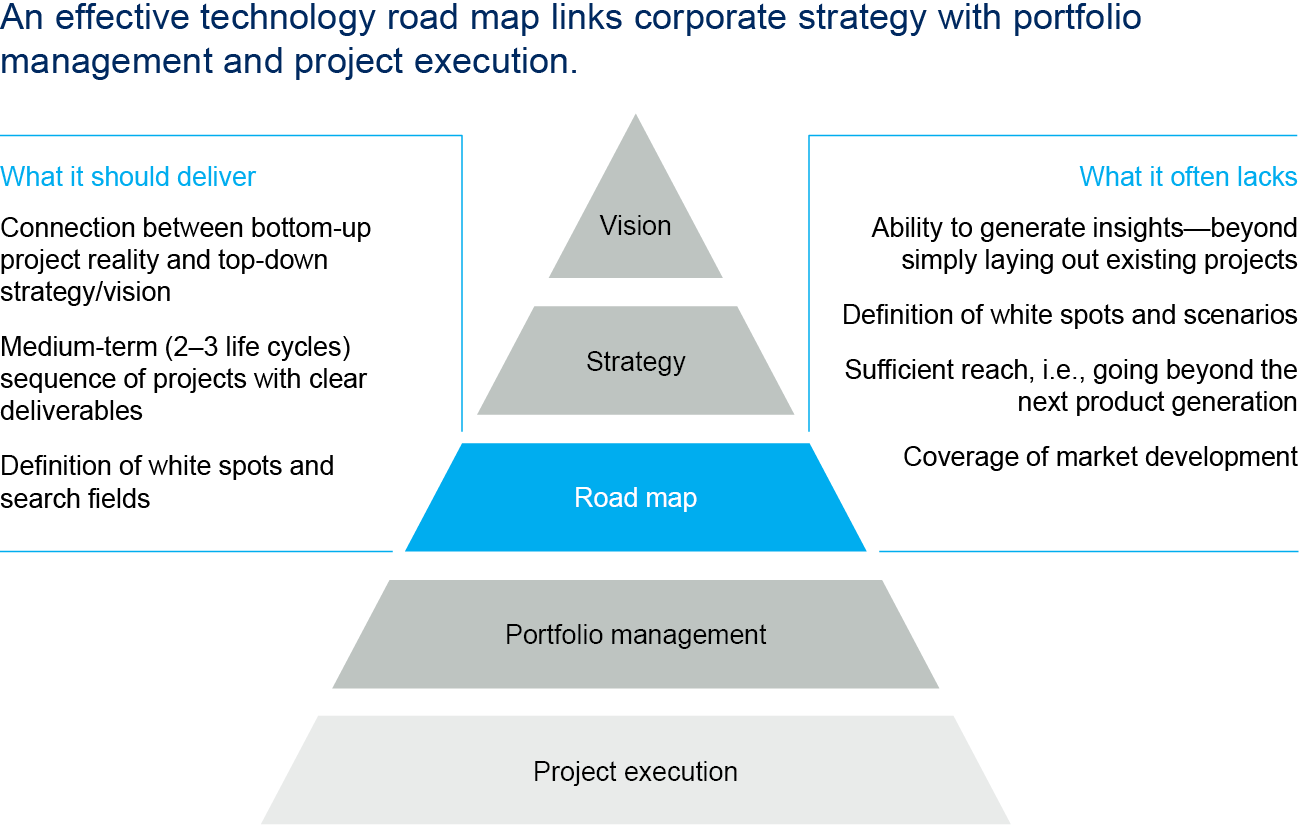
The best technology road maps deliver vital advantages to companies—helping them to:
- Develop the right technologies, capabilities, and organizational structures at the right time, to satisfy customers' changing needs and preferences
- Boost returns on technology investments by focusing resources (including managerial attention) on the technology most likely to unfold
- Enhance transparency into where they are going and what to invest in
- Build consensus on technology innovation plans and foster learning from innovation experiences across different parts of the organization
- Coordinate product development activities within the company and with external organizations by aligning all parties' resources and capabilities behind the long-term innovation and project plan
- Foster clear communication on technology projects between internal and external stakeholders.
Constructing a technology road map that does all this is not easy. We take a closer look at what is required here.
Understanding common pitfalls
When asked what their company's road map looks like, many executives describe something akin to what is shown in Exhibit 2, which is drawn from the historic example of an automotive OEM. This road map is all too typical, in several respects. For one thing, it shows only the company's existing projects, which are tightly constrained by current realities. For instance, power train innovations are focused on fulfilling emission requirements. What is more, the road map does not look very far into the future; the projects mapped here represent just two development life cycles (typically seven years in the automotive industry). It also fails to identify white spots (such as electric drive as an alternative power train strategy) or to offer a holistic view on how technologies and markets may change—and what such changes imply for development plans.
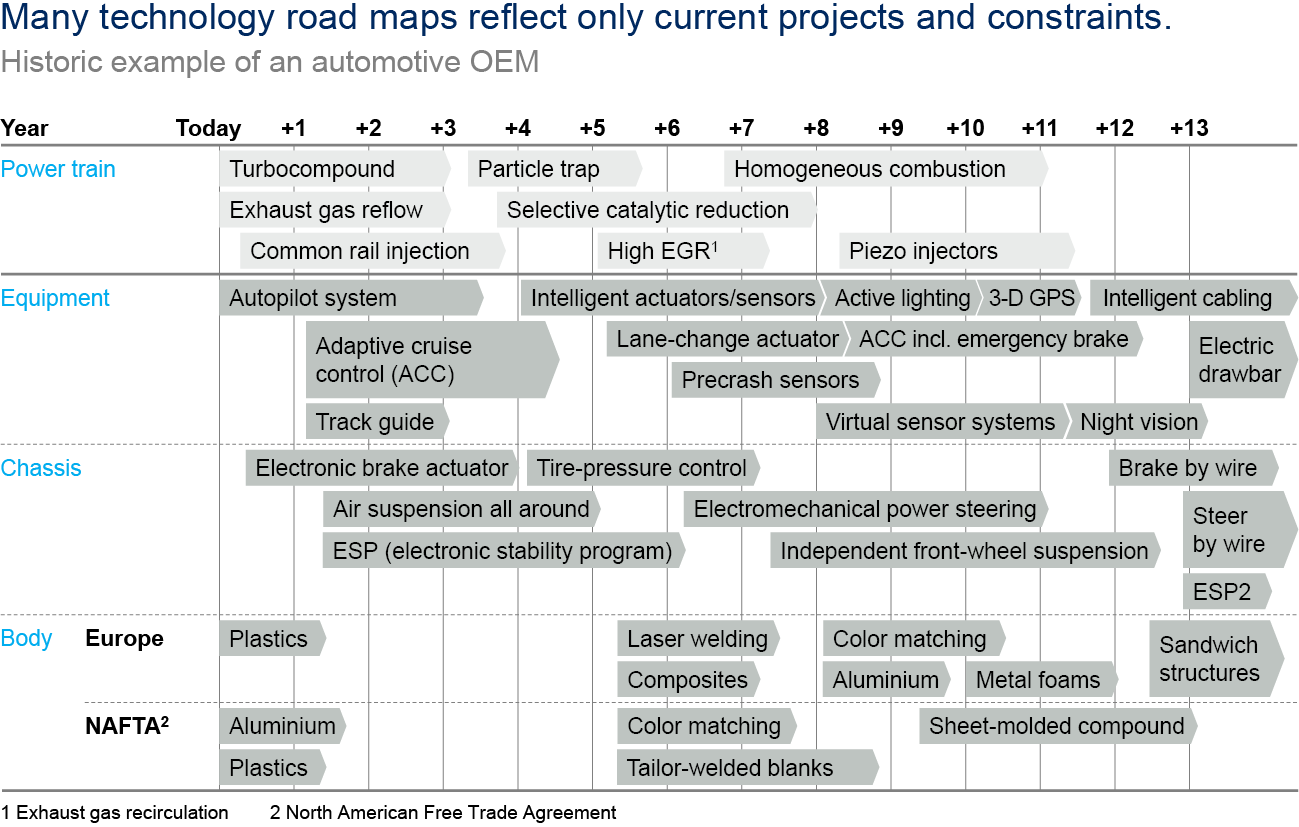
Road maps like these do not encourage managers to adopt a mind-set that encompasses innovations that go beyond incremental, short-term refinements of existing products or services. Consequently, companies that rely on such road maps miss out on opportunities to innovate. They also set aside questions about the kinds of technology projects managers should focus on or the best ways to align critical business capabilities, such as software-development or advanced-analytics capabilities, and organizational structures for the future.
Challenges and dilemmas in building a technology road map
Companies that aspire to go further face several challenges in building a technology road map—we have dubbed these challenges the moving-target dilemma ("How will markets change in the future?"), the resource-focus dilemma ("Which of the multiple options facing us should we allocate our limited resources to?"), and the evolution-revolution dilemma ("Should we emphasize incremental or breakthrough innovations in our project portfolio?"). We will examine each dilemma in greater detail.
The moving-target dilemma
The further into the future a technology road map looks, the more a company's innovation objectives become a moving target. Longer-term innovation plans entail time frames of different lengths, depending on the typical innovation life cycle of the product or service in question. For example, the life cycle for consumer electronics would typically be two to three years. For cars, it might be eight to ten years. With longer innovation life cycles, nobody can know with certainty how customers' needs and behaviors will develop or how technology will advance—and what those shifts will mean for the competitive landscape.
Yet teams building technology road maps can still take steps to envision and plan for a range of potential scenarios. Examples include analyzing global megatrends such as urbanization, digitization, and the growth of the global middle class, as well as considering their implications for companies' innovation strategies. Teams can form assumptions about future developments, envision a number of potential scenarios, and gauge the probability of each scenario coming to pass. Teams can also use mathematical functions or models to estimate the probability of mutually exclusive or interdependent scenarios manifesting themselves.
From there, teams can construct a backward-reaching timeline for their technology road map—one that traces long- and medium-term milestones and decisions back to shorter-term innovations the company has planned. In crafting this timeline, it is vital that teams not overlook developments that may emerge in the long term just because analysis suggests they are not very likely. For instance, in the section of an automotive OEM's road map that focuses on power train innovations, teams should have taken into account scenarios that do not include the use of internal combustion engines. That way, they can be sure to include in the road map some technologies needed to develop alternative power train innovations such as battery electric vehicles or fuel cell vehicles, even if they think non-internal-combustion-engine scenarios are unlikely to emerge.
By taking this approach, teams can compile a reasonably informed future-state assessment of a landscape that will remain a moving target. They can also identify potential commonalities across multiple scenarios (for instance, the introduction of hybrids), as well as no-go areas—projects that the company should avoid.
The resource-focus dilemma
Companies understand that they will want to prepare for many future options for innovations. But they also realize that there are limited resources (R&D personnel, investment dollars, prototyping and testing facilities, etc.) available to allocate to those options.
Road map teams can address this dilemma with the right planning process—specifically, by taking into account the possible future states they envisioned while managing current projects. To illustrate, consider a semiconductor company that is developing a section of its road map relating to silicon-wafer lithography innovation. Managers at this company already know what pattern resolution and throughput the lithography equipment requires for the next decade. With such a clear target, the managers need to determine how to allocate resources to only a few other lithography innovation options. Identifying such constraints does not eliminate the resource-focus dilemma, but it helps minimize it.
The evolution-revolution dilemma
To stay competitive, companies need to excel at both evolutionary (incremental) and revolutionary (breakthrough) technology-driven innovation. Further details can be found in the article "Managing your innovation portfolio." The majority of organizations are set up for excellence on the evolutionary piece, including their approaches to product or service development and project management (such as V-model, stage-gate, or milestone processes). However, revolutionary innovations can jeopardize approaches designed for managing such evolutionary projects. This is because the risks inherent in the development of breakthrough innovations do not allow for stringent stage gates or predefined timelines. Inevitably, project delays and resource-planning difficulties will crop up the moment something different from the usual incremental innovation project is fed into the established approach. To manage more radical innovations, companies must adopt a fundamentally different approach, for example, similar to venture capital processes.
Navigating the road map process
Building an integrated technology road map comprises two major phases: the initial setup of the road map and the refinement. Companies can improve the odds of a successful outcome by devoting some time to up-front preparation. Also the road map needs to be updated regularly to reflect new information, technological achievements, etc.
Setting up the road map
In the initial setup phase, managers compile information on and form assumptions about current and future market needs, components that may be needed to develop products or services in the company's innovation pipelines, technology white spots that (if filled) could support development efforts, and organizational designs and structures that may help. They use the resulting analyses and assumptions to compile a set of innovation scenarios and assess the likelihood of success for each (Exhibit 3).
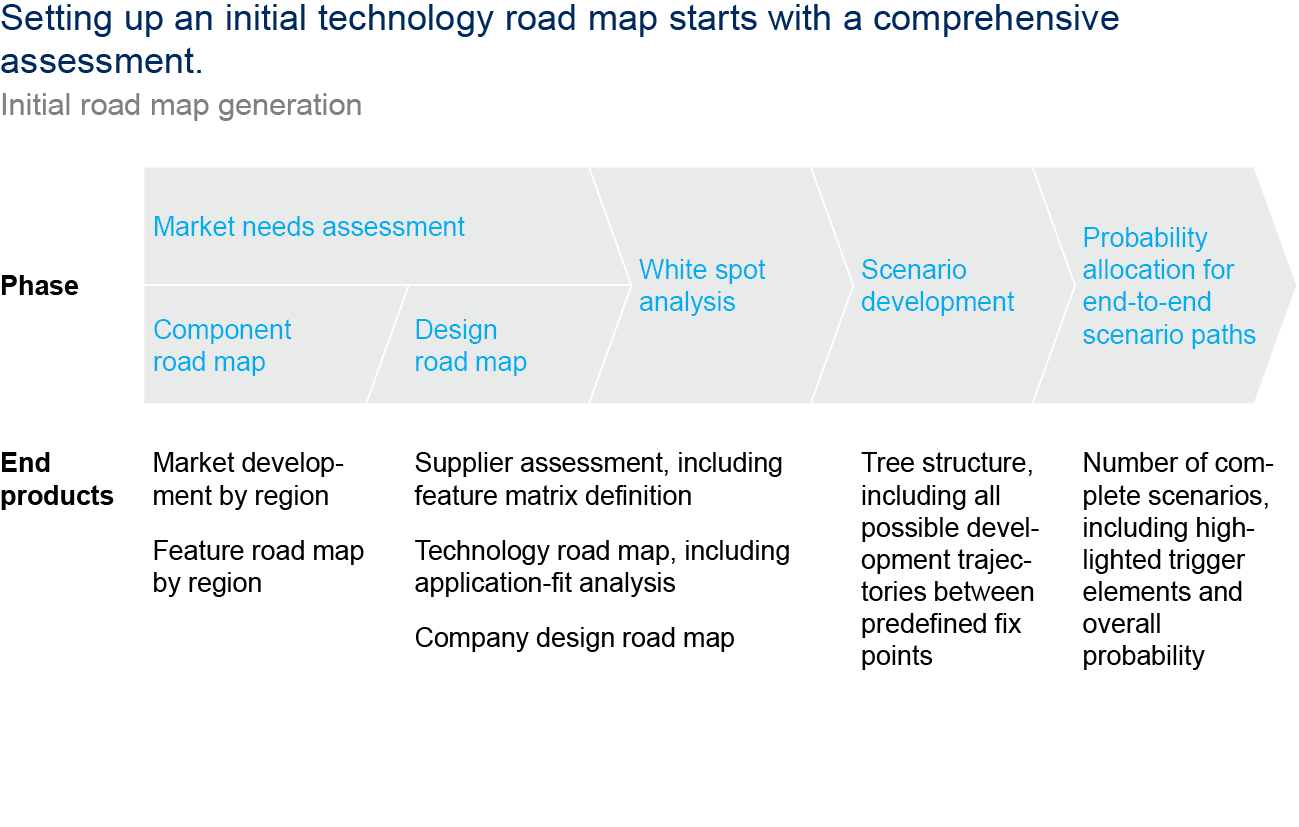
Refining the road map
In the refinement phase (Exhibit 4), managers prioritize the scenarios they have defined, according to criteria such as how well different projects would support the company's competitive strategy and whether the business has the capabilities needed to ensure a project can be executed successfully. Managers then build a product road map showing how required technologies, components, and product or service features align for each prioritized innovation scenario. Next, they consider possibilities for compiling a portfolio of technology projects. At this point, they should address questions such as how many of each type of project the portfolio should contain, which projects may have interdependencies (for instance, a released electronic brake actuator will be required before brake by wire), and how acquisitions of needed technologies or components must be sequenced. Once projects in the portfolio have been launched, managers identify and address challenges that arise—such as cost overruns, delays, or quality problems—and adjust the road map as needed (for example, reprioritizing scenarios) to reflect emerging realities.
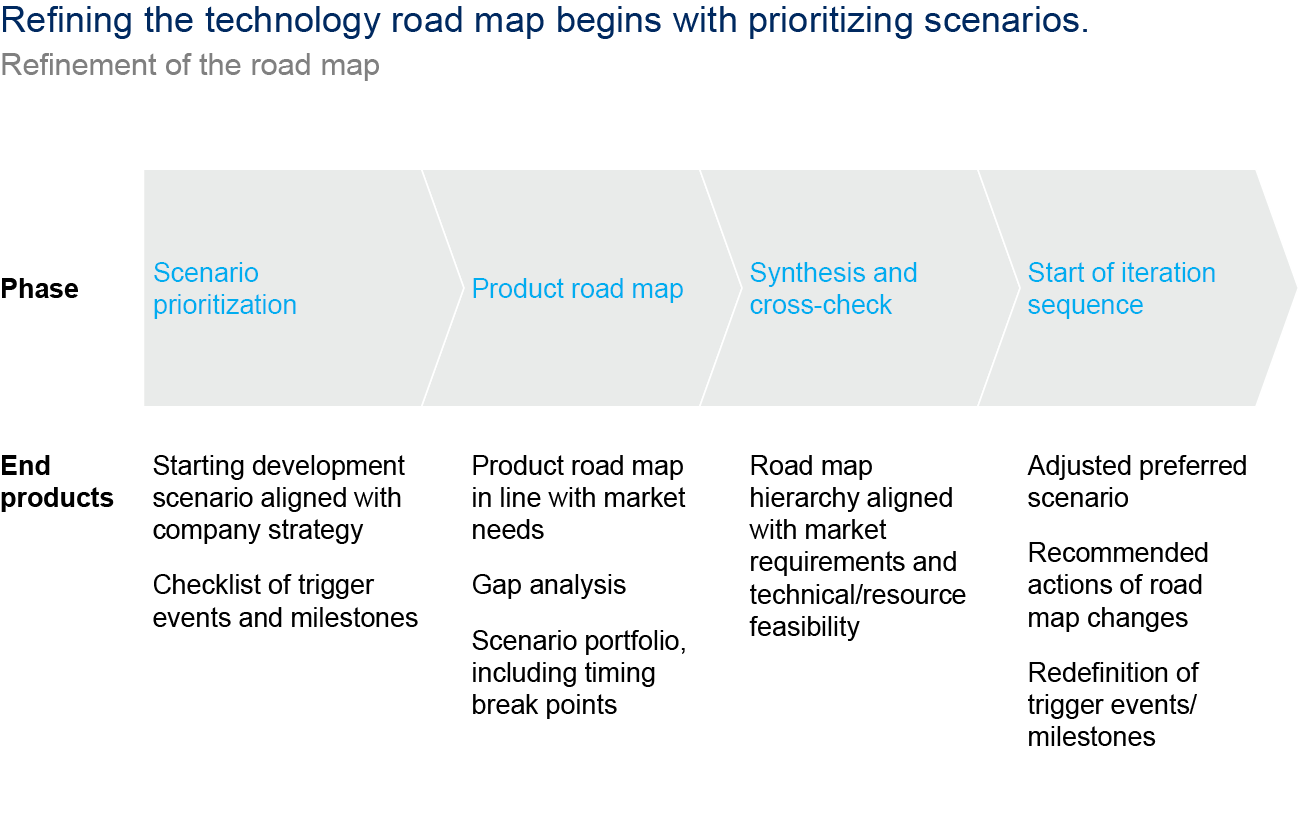
Developing and prioritizing innovation scenarios will demand the biggest time investment across the two phases. Participants in the road-map-building process use probability tools and methods to assess the likelihood of potential end states, and they identify intermediate building blocks and common milestones shared by the short-, medium-, and long-term innovation scenarios they are evaluating. All participants take time to thoroughly discuss the details associated with the scenarios and to double-check for completeness of innovation, identify and agree on white spots, and highlight mutual interdependencies across scenarios. Armed with this information, participants can assign a probability of success to each scenario, develop a concrete list of milestones, articulate the assumptions behind their assessments, and agree on possible go/no-go decision points for each scenario.
At the same time, those taking part in building the road map need to determine whether the organization has sufficient internal capabilities to support the development of the most promising innovation scenarios. After listing the scenarios with the highest potential for success and the immediate actions to realize them, participants can identify steps required to acquire or build needed capabilities. Examples include setting up training programs, hiring experts with specific knowledge or skills, and crafting plans to gain new competencies through a merger or acquisition.
Setting the stage for a successful road map
The initial setup phase starts with well-defined tasks for gathering information on several fronts. It entails a major effort at the corporate level and requires the heavy involvement of internal experts (such as division heads and chief engineers) and external experts. To manage this phase effectively, companies can assemble a team of dedicated specialists for each area of assessment to compile such information and use it to create a comprehensive view of their area. Owing to the many different people involved during this phase, companies should develop a precise plan for how the varied players will interact, well ahead of the process. This plan should include timelines and the nature of stakeholders' involvement and responsibilities.
Designating a facilitator to help guide the road map setup and refinement process can enhance the odds of a successful effort. This individual should have the backing of senior management but should not have too much expertise in any of the areas that will be assessed. This is particularly important when there are large differences among functions regarding the direction and vision for future technology. Why? The facilitator needs to elicit divergent opinions from participants and ultimately encourage them to converge and agree on what will go into the road map. He or she must also ensure that all subsections of the integrated road map are given equal weight and make certain that the road map reflects a balance of views from internal and external participants.
Updating the road map
As with many data collections and information libraries, the moment a technology road map is created, it is already outdated, because the conditions and trends that informed it are constantly shifting. With this in mind, companies must set up a disci-plined process for regularly updating their road maps. Using this process, managers can establish a rhythm for reassessing existing scenarios and the technology, market, and other trends informing those scenarios, and they can decide whether any plans or scenarios need to be revised to reflect important changes (Exhibit 5).
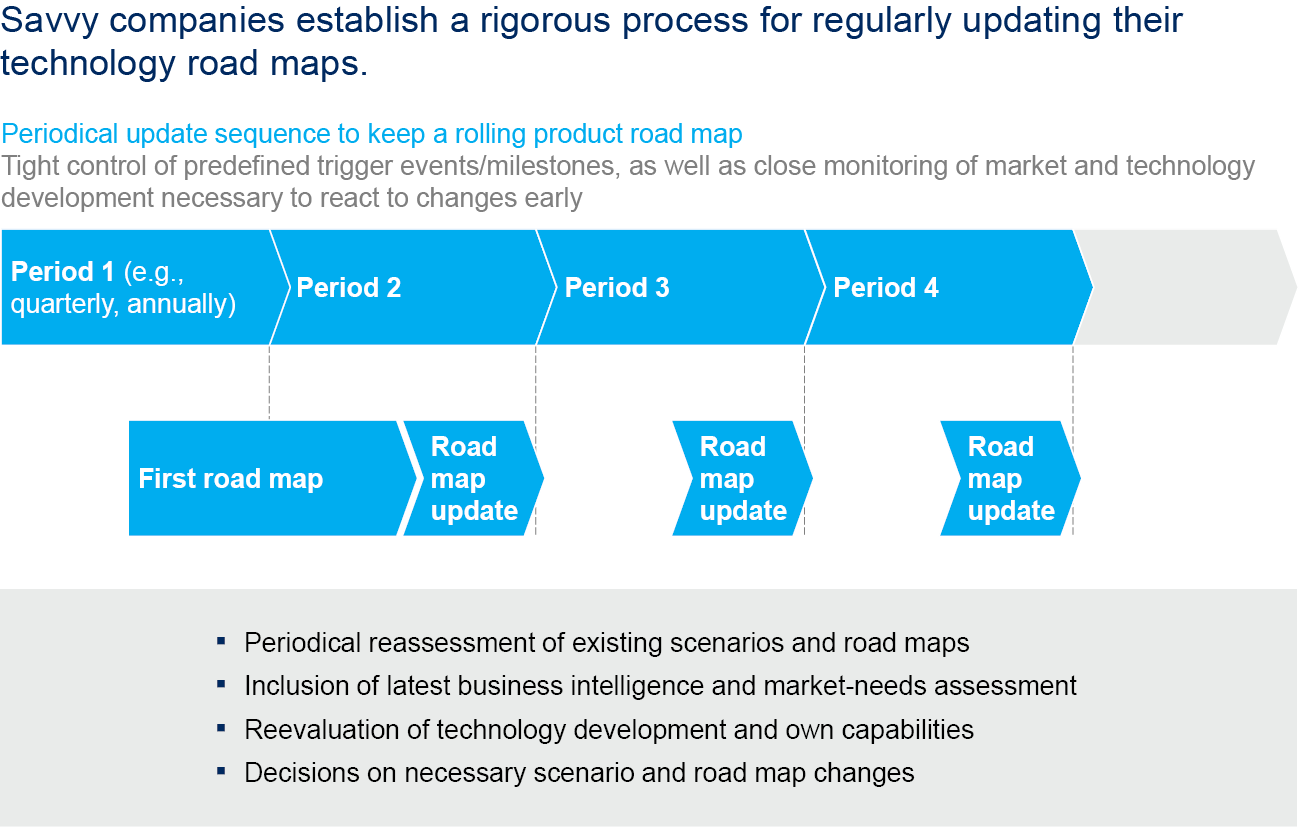
In updating the road map, companies must decide on an iteration rhythm. As a rule of thumb, we recommend at least three rounds of updating per type of innovation scenario (short, medium, and long term). Road maps for longer-term projects should be updated the most frequently because changes in technology can affect projects in development. In selecting an iteration rhythm, companies will have to make trade-offs between accuracy—that is, capturing the latest and greatest technologies—and resource consumption. To provide a few directional examples, we recommend revisiting road maps annually in an automotive setting and quarterly in consumer electronics.
To make these trade-offs, managers can take into account their company's capabilities and the degree of detail they need to gain foresight regarding potential developments in key assessment areas such as technology and market needs. Indeed, because under-standing market needs plays a crucial role in building an integrated technology road map, we devote more attention to the topic in the article "From myopia to foresight."
About the authors: Ulf Heim is a senior expert and Ruth Heuss is a partner in McKinsey's Berlin office, Tova Katzir is a consultant in the Boston office.